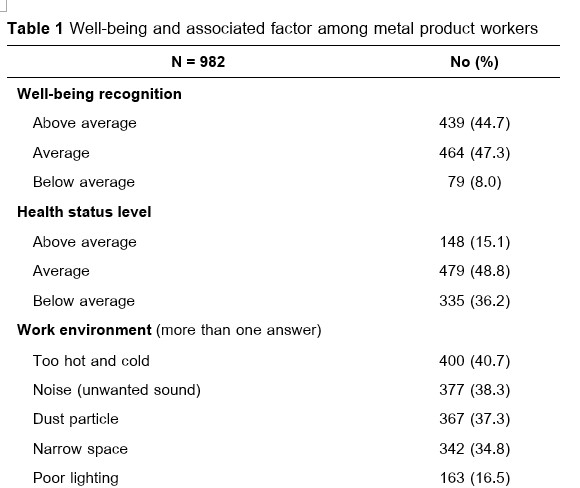The work-related well-being constituents: A preliminary survey
Keywords:
Worker, Work-related, Health, Well-beingAbstract
The aim of the study was to describe the work-related constituent; level of well-being, occupational illness, and workplace environment among 32 metal product SMEs. Overall, the well-being health status level in workplace was recognized in the above average and average 47.3 and 44.7%. Three most common barriers of physical occupational environment were reported: too hot and cold 40.7%, noise (38.3%), and dust particle (37.3%) followed by narrow space (34.8%), and poor lighting (16.5%), respectively. In conclusion, the early findings suggest that physical employee well-being is one of the obstacles, however other dimension of work-related well-being should be further explored.
References
Country Diagnostic Study, Asian Development Bank. Thailand industrialization and economic catch-up. Mandaluyong, Philippines: Asian Development Bank; 2015. 77 p.
Grossmeier J, Fabius R, Flynn JP, Noeldner SP, Fabius D, Goetzel RZ, et al. Linking workplace health promotion best practices and organizational financial performance: tracking market performance of companies with highest scores on the HERO scorecard. J Occup Environ Med. 2016;58(1):16–23.
Fabius R, Thayer RD, Konicki DL, Yarborough CM, Peterson KW, Isaac F, et al. The link between workforce health and safety and the health of the bottom line: tracking market performance of companies that nurture a ‘‘culture of health’’. J Occup Environ Med. 2013;55:993–1000.
Gandy WM, Coberley C, Pope JE, Wells A, Rula EY. Comparing the contributions of well-being and disease status to employee productivity. J Occup Environ Med. 2014;56(3):252–257.
Alistair Dronan of Right Management. The Wellness imperative: Creating more effective organizations. Geneva, Switzerland: The World Economic Forum and Right Management; 2010. 20 p.
Shanafelt TD, Noseworthy JH. Executive leadership and physician wellbeing: Nine organizational strategies to promote engagement and reduce burnout. Mayo Clin Proc. 2017;92(1):129–146.
Diener E. Subjective well-being: the science of happiness and a proposal for a national index. Am Psychol. 2000;55(1):34–43.
Korunka C, Scharitzer D, Carayon P, Hoonakker P, Sonnek A, Sainfort F. Customer orientation among employees in public administration: a transnational, longitudinal study. Appl Ergon. 2007;38(3):307–315.
Gallup. Gallup-Healthways Well-Being Index: Methodology Report for Indexes. Gallup, Inc; 2009.
Ryff CD, Singer B. Psychological well-being: meaning, measurement, and implications for psychotherapy research. Psychother Psychosom. 1996;65(1):14–23.
Makikangas A, Kinnumen U, Feldt T. Warr's scale of job-related affective well-being: A longitudinal examination of its structure and relationships with work characteristics. Work Stress. 2007;21(3):197-219.

Downloads
Published
How to Cite
Issue
Section
License
Copyright (c) 2020 Naresuan Phayao Journal

This work is licensed under a Creative Commons Attribution-NonCommercial-NoDerivatives 4.0 International License.
ผู้นิพนธ์ต้องรับผิดชอบข้อความในบทนิพนธ์ของตน มหาวิทยาลัยพะเยาไม่จำเป็นต้องเห็นด้วยกับบทความที่ตีพิมพ์เสมอไป ผู้สนใจสามารถคัดลอก และนำไปใช้ได้ แต่จะต้องขออนุมัติเจ้าของ และได้รับการอนุมัติเป็นลายลักษณ์อักษรก่อน พร้อมกับมีการอ้างอิงและกล่าวคำขอบคุณให้ถูกต้องด้วย
The authors are themselves responsible for their contents. Signed articles may not always reflect the opinion of University of Phayao. The articles can be reproduced and reprinted, provided that permission is given by the authors and acknowledgement must be given.







